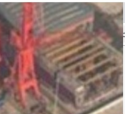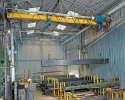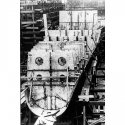It is simply a different approach of building method. Compare with traditional building method, modular building needs far greater precision in all dimensions, errors of few millimetre may be allowed but errors in centimetres can ruin in big time when two large super modules are mated together as every edges and corners of the two modules must match each other millimetre by millimetre before proper welding took place.
Building a ship from keel upwards is far more easy but time consuming, and this method has greater tolerance for errors which can be rectified by mending or cutting away a few inches of unwanted steel plates. The hulls are normally supported by walls aka bulkhead instead of beam, as the ship becomes larger in progress.
Temporary use of beams and pillars are there to prevent deformation take place, this is critical especially you do not want a deformation of even just a few millimetres. This does not mean Chinese ships do not have bulkheads to support the hull as in western ships, they know better than anyone else since ship bulkhead was a Chinese invention hundreds of years ago. Or you can say it is simply an over-engineering in methods of building a ship.
Yes, its a "fixture" or "jig", they are often used when rebuilding aircraft structure, to support surrounding material position, as parts are removed, straightened or replaced, and re riveted or welded as in the case of ships.
it would ensure accuracy in new construction.












